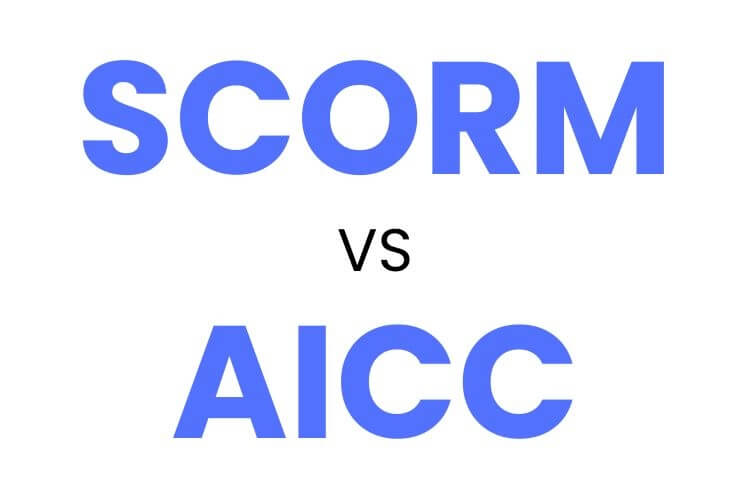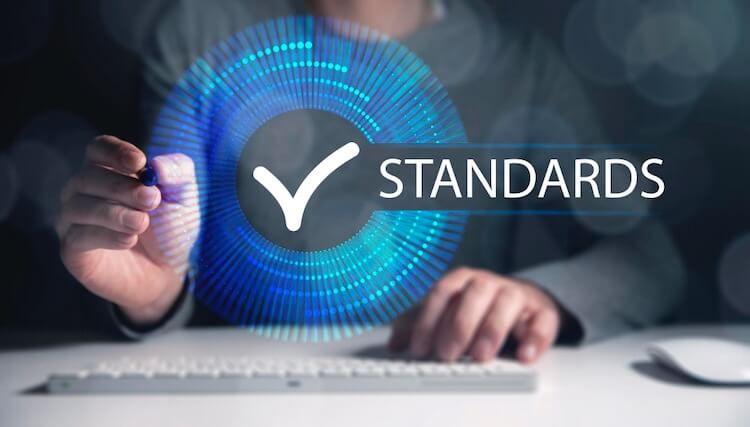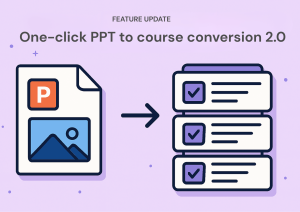
SCORM vs AICC: A Guide to Choosing the Right Standard
- Author: Urban Rotar
- Published:

What is the main difference between SCORM and AICC?
SCORM is widely supported and easier to use, making it great for most online courses. AICC, though less common, offers advanced tracking and security, but requires more technical expertise to implement and maintain.
Which standard is better for tracking learner progress?
AICC provides more detailed tracking and reporting capabilities, making it ideal for industries that need robust oversight. SCORM, while easier, has limited tracking.
What is xAPI?
xAPI is a newer eLearning standard that tracks learning experiences inside and outside traditional LMS environments, offering advanced reporting capabilities through a Learning Record Store (LRS).
Key Takeaways - SCORM vs AICC:
SCORM is widely supported and easier to integrate with most Learning Management Systems, making it ideal for most online courses.
AICC offers advanced tracking and security features but requires more technical expertise for integration and maintenance.
xAPI provides a modern solution for tracking learning experiences beyond traditional LMS environments.
Creating tokens in crypto involves building digital assets on a blockchain for various transactions and utilities.
When choosing between SCORM and AICC, consider your course’s complexity, audience needs, and LMS capabilities.
Introduction to eLearning Standards
When developing online courses, understanding eLearning standards is key to ensuring compatibility and efficiency in the learning process. Standards help Learning Management Systems (LMS) communicate smoothly with course content, ensuring a seamless experience for learners. Whether you’re creating corporate training modules or academic eLearning courses, the right standard will allow you to track progress, monitor success, and deliver engaging learning materials.
In the world of eLearning, two prominent standards stand out—SCORM and AICC. But how do you choose which one is best for your needs?
Importance of eLearning Standards for Online Courses
eLearning standards play a critical role in the success of online courses. They guarantee that the content can communicate effectively with the Learning Management System, enabling the tracking of a learner’s progress. When these standards work as intended, they allow educators and trainers to design courses that not only engage learners but also deliver measurable outcomes.
For online courses to work effectively, understanding these standards is crucial. By aligning your course design with the right standard, you help create a system where learning content and the LMS can interact seamlessly. This ultimately leads to a smooth experience for both course creators and learners alike.

Brief Overview of SCORM and AICC
SCORM, or Sharable Content Object Reference Model, is the more commonly used standard today. It focuses on packaging eLearning content to ensure it works across a wide variety of LMS platforms. On the other hand, AICC, developed by the Aviation Industry Computer-Based Training Committee, is an older eLearning standard still in use, particularly in sectors requiring high levels of security.
Though both SCORM and AICC serve the same basic purpose—enabling communication between eLearning content and an LMS—they differ significantly in their technical details and practical applications. Choosing between them depends largely on your specific needs, including the type of eLearning course you’re developing and the LMS you’re working with.
Understanding SCORM and AICC
Introduction to SCORM
SCORM is widely regarded as the industry standard for eLearning content. Developed by the U.S. Department of Defense, SCORM simplifies the process of distributing online learning content by ensuring compatibility with most Learning Management Systems. SCORM does this by establishing a set of rules for packaging content, enabling it to be read, tracked, and managed by LMS platforms.
The most popular versions, SCORM 1.2 and SCORM 2004, are known for their ease of use and widespread support. Many organizations prefer SCORM for its ability to facilitate a smooth learner experience and its relatively simple integration into modern LMS platforms. If you’re working with SCORM-compliant courses, uploading and managing content becomes a fairly straightforward process.
Introduction to AICC and the HTTP AICC Communication Protocol
AICC, by contrast, was designed for industries that needed to ensure a high degree of security and tracking. It uses the HTTP AICC communication protocol, which sets up communication between the LMS and the learning content. This system is especially appealing to industries that need rigorous oversight and tracking capabilities, such as aviation and defense.
AICC-compliant courses, however, tend to require more manual work. In some cases, developers may need to modify code to ensure AICC content communicates properly with the LMS. While AICC offers a robust system for tracking learning data, it can be more complex to implement and maintain than SCORM.
Key Differences and Considerations
Comparison of SCORM and AICC Strengths and Weaknesses
SCORM’s primary strength lies in its simplicity and widespread support. Most Learning Management Systems are SCORM-compliant, which means that SCORM courses can be easily uploaded, tracked, and reported. However, SCORM’s tracking capabilities are somewhat limited in comparison to AICC. If you need detailed tracking of a learner’s performance, SCORM might not meet all your requirements.
AICC, though less widely supported, excels in environments that require detailed reporting and high levels of security. The HTTP AICC communication protocol provides the advanced tracking that SCORM lacks. However, AICC is more complex to use, and fewer LMS platforms natively support it.
Differences in Functionality and Features
One of the key features of SCORM is the ability to control learner pacing. This makes it easier to monitor how long learners spend on interactive elements, helping instructors gauge engagement. AICC, on the other hand, focuses more heavily on reporting. While it doesn’t offer the same level of control over pacing, it provides more detailed data on learner performance.
SCORM is designed with the general learner in mind, while AICC offers more advanced tracking for industries with specific compliance requirements. The choice between the two largely comes down to whether you prioritize ease of use or the ability to track granular details.

Impact on Learning Management System (LMS) Integration
When it comes to integrating your content into an LMS, SCORM has a distinct advantage due to its wide support. Most Learning Management Systems readily accept SCORM-compliant content, which allows for easier integration and fewer technical hurdles. SCORM-compliant courses are packaged in a .zip file, containing multimedia and structured data that can be easily managed by any SCORM-compliant LMS.
AICC integration, however, can be more complex. Not all LMS platforms support AICC natively, and those that do may require manual coding adjustments to ensure proper functionality. An AICC-compliant LMS must meet specific requirements to host, store, distribute, and track AICC content.
Compliant Courses
What are SCORM Compliant Courses?
SCORM-compliant courses are essentially packaged to work with any SCORM-compliant LMS. The courses themselves are structured with HTML, XML, and multimedia files, all contained within a .zip package. This package makes it simple for administrators to upload, track, and report learner progress across a variety of learning management systems.

Benefits of Using SCORM Compliant Courses
SCORM’s ease of use, coupled with its broad compatibility, makes it the go-to standard for many eLearning developers. SCORM-compliant courses enable seamless communication between content and the LMS, allowing for smooth tracking and reporting of learner activities.
Creating Compliant Courses for AICC
Creating AICC-compliant courses requires a bit more technical expertise. Developers often need to manually tweak the code to ensure proper communication between the course content and the LMS. While this adds complexity to the development process, AICC-compliant courses provide a higher level of reporting and tracking. This makes AICC more attractive to industries that require in-depth monitoring, such as aviation and defense.
Implementation and Maintenance
Integrating SCORM and AICC With Your LMS
Integrating SCORM into your LMS is relatively straightforward. The standard is widely supported, meaning that most Learning Management Systems can handle SCORM-compliant content with little trouble. On the other hand, AICC integration might be trickier. Depending on your LMS, you may need to perform some manual coding or adjustments to ensure the AICC content works as expected.

Troubleshooting Common Issues
Integration problems with both SCORM and AICC are not unheard of. Common issues include compatibility errors, failure to track progress accurately, and communication breakdowns between the content and the LMS. If you’re not familiar with the technical aspects of these standards, you might need to enlist the help of an eLearning expert to resolve these problems.
Choosing the Right Standard
Factors to Consider When Choosing a Standard
When choosing between SCORM and AICC, several factors come into play. First, consider the type of eLearning course you’re developing and the audience you’re targeting. If you’re creating simple online courses for general learners, SCORM is likely the better fit. If your content requires complex tracking and high security, AICC might be more appropriate.
How to Choose Between SCORM and AICC
For most organizations, SCORM is the go-to standard due to its broad compatibility and ease of use. However, if you need more sophisticated tracking and reporting, AICC could provide what SCORM lacks. The decision ultimately hinges on your Learning Management System and the specific needs of your course.
xAPI: An Alternative to SCORM and AICC

What is xAPI?
xAPI, or Experience API, is a newer standard designed to track learning experiences both inside and outside of traditional LMS environments. It works with a Learning Record Store (LRS) to capture and store learning data, enabling more flexible and advanced reporting.
How xAPI Works
Unlike SCORM and AICC, xAPI uses a more dynamic system of “noun, verb, object” statements to define learning activities. This allows it to track everything from informal learning experiences to social learning, providing a more complete picture of a learner’s journey.
Benefits of Using xAPI
The biggest advantage of xAPI is its ability to track learning activities beyond the LMS. Whether a learner is engaging with online courses or participating in offline learning, xAPI can capture that data and store it in an LRS.

Conclusion on SCORM vs AICC
Both SCORM and AICC have their strengths and weaknesses. SCORM is widely supported and easy to use, making it a great choice for most eLearning courses. AICC, on the other hand, provides enhanced tracking and security for industries that need it. Meanwhile, xAPI offers a forward-looking alternative for those wanting advanced tracking capabilities across multiple learning platforms.
Ultimately, your choice should be guided by the specific needs of your online course, your LMS, and the level of reporting and security you require.



